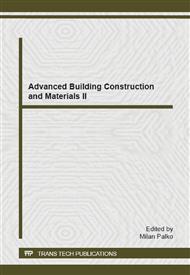p.163
p.171
p.180
p.188
p.196
p.204
p.215
p.223
p.231
Problems of Current Classification of Building Materials in the Context of Solution of Structure Fire Safety
Abstract:
Fire safety, as one of six basic requirements for structures in Slovakia, does not reflect the increase of innovative solutions during last years in the field of building industry. At the present time, energy economy of structures sets the character of structures forming the heat exchange envelope of the building. Continuous demand for the application of ecological materials increases requirements for optimizing the existing or creating new procedures in the solution of fire safety of structures. The existing classification of building structures appears, from the point of view of fire safety, as insufficient one. Comparative analysis of different structural compositions of external cladding is the method that demonstrates in this paper unsuitability of criteria set. The development of new procedures can make more effective and can optimize requirements without any negative impacts on resulting fire safety of the structure.
Info:
Periodical:
Pages:
204-211
Citation:
Online since:
October 2014
Authors:
Keywords:
Price:
Сopyright:
© 2014 Trans Tech Publications Ltd. All Rights Reserved
Share:
Citation:


